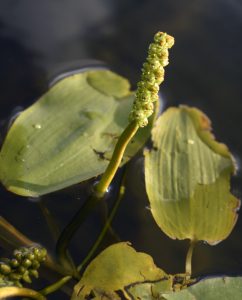Floating Pondweed

Potamogeton natans may be a familiar sight while boating through just about any body of water — lakes, ponds, streams and rivers. Derived from Latin and Greek, the nomenclature translates roughly as ‘floating river neighbor’. June through September, floating pondweed sends a smallish, green spike densely packed with whorls of green flowers up to the water’s surface. Taking a closer look, you will find the flowers to consist of a 4-part style (female structure) resembling tiny petals, accompanied by stamens (pollen structures) with rounded green appendages.
Along with the oval-shaped leaves (up to 4″ long) that float on top of the water, pondweed also forms thin blades of underwater leaves, roundish in cross section that may disintegrate by the time the fruit ripens. Surface leaves vary based on the type of water. In the calm, still waters of lakes, the leaves will be wider, while those of plants growing in fast moving streams will form narrower.
All kinds of life flock to these plants — insects resting on the floating leaves, dragonflies laying eggs on leaf undersides, schools of fish sheltering beneath and darting between the stems. After flowering is finished, the tightly packed ovaries on the spike become translucent and form into compact seed heads, falling over to lie sideways and ripen into a yummy and nutritious snack for water fowl. Mammals such as muskrat, beavers, deer and moose all consume portions of this plant as well.
